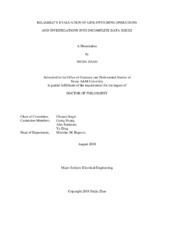| dc.contributor.advisor | Singh, Chanan | |
| dc.creator | Zhao, Shijia | |
| dc.date.accessioned | 2019-01-18T13:59:58Z | |
| dc.date.available | 2020-08-01T06:39:16Z | |
| dc.date.created | 2018-08 | |
| dc.date.issued | 2018-07-02 | |
| dc.date.submitted | August 2018 | |
| dc.identifier.uri | https://hdl.handle.net/1969.1/173891 | |
| dc.description.abstract | Research in this dissertation is mainly focused on two topics: reliability evaluation of line switching operations and the investigation into incomplete data issues observed in reliability evaluation.
A method is proposed for studying the reliability implications of line switching operations in power systems. This method is designed to explore previously overlooked areas, study objectives and study measures, in reliability evaluation of line switching operations. Line removal test is proposed to obtain simulation data of the system, and then with risk analysis and impact analysis, six reliability indices are used to evaluate reliability performance of each transmission line in the system. Weibull distribution is used to reconstruct distributions of reliability indices which provide variance analysis and worst-case scenario comparisons. Eventually, with results obtained, categorization for line switching operations is introduced to classify all transmission lines based on their reliability performance. The categories provide reliability implications of line switching operations and can be used for guidance in actual operations. This method is tested in two case studies: IEEE Reliability Test System (RTS) and IEEE 118-bus system. Both case studies validate the effectiveness of this method.
A contingency ranking (CR) method is introduced as a pre-selection method to create a hybrid reliability evaluation method. The objective is not only to speed up the simulation but also to provide analytical analysis of state space. The differences between event-based and yearly-based indices are analyzed to better understand the results of the proposed method. Two case studies on IEEE RTS and IEEE 118-bus system conclude that this method have high accuracy in identifying critical lines with a significant improvement in calculation speed.
To resolve incomplete data issues observed in reliability evaluation, mathematical conditions are derived for the probabilities obtained from the Markov model using transition rates to be identical with those obtained from the state residence times. This research provides guidance on building or recovering transition rate matrix in the absence of complete data. This research also shows equivalent transition rates with implicit assumption of exponential distribution is not affected by the probability distribution of state residence times in steady state analysis. | en |
| dc.format.mimetype | application/pdf | |
| dc.language.iso | en | |
| dc.subject | Reliability Evaluation | en |
| dc.subject | Line Switching Operation | en |
| dc.subject | Contingency Ranking | en |
| dc.subject | Hybrid Evaluation | en |
| dc.subject | Topology Control | en |
| dc.subject | Incomplete Data | en |
| dc.subject | | en |
| dc.title | Reliability Evaluation of Line Switching Operations and Investigations into Incomplete Data Issues | en |
| dc.type | Thesis | en |
| thesis.degree.department | Electrical and Computer Engineering | en |
| thesis.degree.discipline | Electrical Engineering | en |
| thesis.degree.grantor | Texas A & M University | en |
| thesis.degree.name | Doctor of Philosophy | en |
| thesis.degree.level | Doctoral | en |
| dc.contributor.committeeMember | Huang, Garng | |
| dc.contributor.committeeMember | Sprintson, Alex | |
| dc.contributor.committeeMember | Ding, Yu | |
| dc.type.material | text | en |
| dc.date.updated | 2019-01-18T13:59:59Z | |
| local.embargo.terms | 2020-08-01 | |
| local.etdauthor.orcid | 0000-0002-6372-6779 | |


